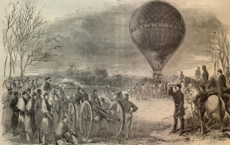
In modern day the British Army has three main sections, the Land forces, the Air force and the Navy, but air power is a very recent innovation in warfare, so how does it compare to land and sea and where did it come from?
Even before powered flight became possible man has looked to gain an advantage over the enemy in war from the skies. Originally for reconnaissance purposes rather than as a weapon, the early significance of aerial warfare can be seen as early as the 1800s when hot air balloons were used in the American Civil War (1861-65) and also in the Siege of Paris 1870-71 in the Franco Prussian War. This allowed for a bird’s eye view of a battlefield and could provide such intelligence as the positioning and movement of enemy forces. In the years of advancing line warfare such as in the American Civil War this sort of intelligence was otherwise very difficult to obtain and with the somewhat limited range of warfare tactics at that time it could provide a huge advantage in choosing where to position troops, for example taking the high ground in a battle. Therefore the valuable intelligence that early aerial development in warfare could provide is highly significant and as aerial drones are still used in modern warfare for reconnaissance missions it proves their worth, even if the technology has become somewhat more advanced in recent years.
The potential of the sky as a component of war was soon realised and the first military use of aerial warfare was seen in the Italo - Turkish war on November 1st 1911 when the first ever aerial bomb was dropped by Sottotenente Giulio Gavotti, on Turkish troops in Libya. The advantage of aerial warfare granted the Italians a great advantage and they won the war; this was the beginning of aerial warfare and even at this very early stage it was proving highly significant, powerful and a key advantage over the enemy. The First World War (1914-1918) saw biplanes became armed for the first time and soldiers in the trenches were highly vulnerable to fire swooping down upon them from the skies. Though the aeroplanes in World War I were used mainly for reconnaissance purposes and redirecting artillery fire, their ability to change the course of war was recognised and the sluggish trench style war of attrition was soon replaced by innovative fast moving battle strategies such as the ‘Blitzkrieg’ Hitler’s forces employed to capture Europe in such a short time [1]which relied heavily on the Messerschmitt fighter plane and Stuka dive bomber.
The importance of the new founded aerial warfare was seen later in the Battle of Britain (1940) also as Hitler refused to invade before winning aerial superiority over Britain due to the large advantage it gave. Similarly, the success of the allied sweep across Western Europe from the Normandy Landings in June 1944 was largely due to the complete aerial superiority of allied forces; thus it is clear to see that the development of aerial warfare in this period was highly significant as it forced large changes in the conduct of war from 1914 onwards, in particular as speed rather than manpower became a crucial factor in warfare. Perhaps the most devastating significance of the development of aerial warfare was the nuclear capabilities it provided. Though no more weapons of mass destruction have been used since American airmen dropped ‘Little Boy’ on Hiroshima on 6th August 1945 and Fat Man on Nagasaki on 9th August 1945, nuclear weaponry was developed after World War Two and, during the Cold War, (particularly in the early 1960s) the US and Soviets raced to test launch ever increasingly powerful nuclear bombs and missiles. Though a terrifying prospect, the capability to carry and deploy weapons of mass destruction provided by the development of aerial warfare in this period was hugely significant.

0 Comment:
Be the first one to comment on this article.